Drug Detail:Emend (Aprepitant (oral/injection) [ a-prep-i-tant ])
Drug Class: NK1 receptor antagonists
Highlights of Prescribing Information
EMEND (aprepitant) capsules, for oral use
EMEND (aprepitant) for oral suspension
Initial U.S. Approval: 2003
Indications and Usage for Emend
EMEND® is a substance P/neurokinin 1 (NK1) receptor antagonist.
EMEND for oral suspension is indicated
- in combination with other antiemetic agents, in patients 6 months of age and older for prevention of:
- acute and delayed nausea and vomiting associated with initial and repeat courses of highly emetogenic cancer chemotherapy (HEC) including high-dose cisplatin (1)
- nausea and vomiting associated with initial and repeat courses of moderately emetogenic cancer chemotherapy (MEC) (1)
EMEND capsules is indicated
- in combination with other antiemetic agents, in patients 12 years of age and older for prevention of:
- acute and delayed nausea and vomiting associated with initial and repeat courses of highly emetogenic cancer chemotherapy (HEC) including high-dose cisplatin (1)
- nausea and vomiting associated with initial and repeat courses of moderately emetogenic cancer chemotherapy (MEC) (1)
Limitations of Use (1)
- EMEND has not been studied for treatment of established nausea and vomiting.
- Chronic continuous administration of EMEND is not recommended.
Emend Dosage and Administration
Recommended Dosage (2.1)
- EMEND capsules in adults and pediatric patients 12 years of age and older: is 125 mg on Day 1 and 80 mg on Days 2 and 3.
- EMEND for oral suspension in pediatric patients 6 months to less than 12 years of age or pediatric and adult patients unable to swallow capsules: see dosing recommendations in Table 3 in the Full Prescribing Information.
- Administer EMEND 1 hour prior to chemotherapy on Days 1, 2, and 3. If no chemotherapy is given on Days 2 and 3, administer EMEND in morning.
- See Full Prescribing Information for recommended dosages of concomitant dexamethasone and 5-HT3 antagonist for HEC and MEC.
Preparation and Administration (2.2, 2.3)
- EMEND capsules and EMEND for oral suspension can be administered with or without food.
- Swallow EMEND capsules whole.
- EMEND for oral suspension should be prepared by healthcare provider. Once prepared, it may be administered either by a healthcare provider, patient, or caregiver.
- For details on preparation see Full Prescribing Information.
Dosage Forms and Strengths
EMEND capsules: 80 mg and 125 mg (3)
EMEND for oral suspension: 125 mg (3)
Contraindications
- Known hypersensitivity to any component of this drug. (4)
- Concurrent use with pimozide. (4)
Warnings and Precautions
- CYP3A4 Interactions: Aprepitant is a substrate, weak-to-moderate inhibitor and inducer of CYP3A4; See Full Prescribing Information for recommendations regarding contraindications, risk of adverse reactions, and dosage adjustments of EMEND and concomitant drugs. (4, 5.1, 7.1, 7.2)
- Warfarin (a CYP2C9 substrate): Risk of decreased INR of prothrombin time; monitor INR in 2-week period, particularly at 7 to 10 days, following initiation of EMEND. (5.2, 7.1)
- Hormonal Contraceptives: Efficacy of contraceptives may be reduced during administration of and for 28 days following the last dose of EMEND. Use effective alternative or back-up methods of contraception. (5.3, 7.1, 8.3)
Adverse Reactions/Side Effects
Most common adverse reactions (≥3%) are (6.1):
- Adults: fatigue, diarrhea, asthenia, dyspepsia, abdominal pain, hiccups, white blood cell count decreased, dehydration, and alanine aminotransferase increased.
- Pediatrics: neutropenia, headache, diarrhea, decreased appetite, cough, fatigue, hemoglobin decreased, dizziness, and hiccups.
To report SUSPECTED ADVERSE REACTIONS, contact Merck Sharp & Dohme LLC at 1-877-888-4231 or FDA at 1-800-FDA-1088 or www.fda.gov/medwatch .
Drug Interactions
See Full Prescribing Information for a list of clinically significant drug interactions. (4, 5.1, 5.2, 5.3, 7.1, 7.2)
See 17 for PATIENT COUNSELING INFORMATION and FDA-approved patient labeling.
Revised: 5/2022
Full Prescribing Information
1. Indications and Usage for Emend
EMEND® for oral suspension, in combination with other antiemetic agents, is indicated in patients 6 months of age and older for the prevention of:
- acute and delayed nausea and vomiting associated with initial and repeat courses of highly emetogenic cancer chemotherapy (HEC) including high-dose cisplatin.
- nausea and vomiting associated with initial and repeat courses of moderately emetogenic cancer chemotherapy (MEC).
EMEND® capsules, in combination with other antiemetic agents, is indicated in patients 12 years of age and older for the prevention of:
- acute and delayed nausea and vomiting associated with initial and repeat courses of highly emetogenic cancer chemotherapy (HEC) including high-dose cisplatin.
- nausea and vomiting associated with initial and repeat courses of moderately emetogenic cancer chemotherapy (MEC).
2. Emend Dosage and Administration
2.1 Recommended Dosage
Adults and Pediatric Patients 12 Years of Age and Older
The recommended oral dosage of EMEND capsules, dexamethasone, and a 5-HT3 antagonist in adults and pediatric patients 12 years of age and older who can swallow oral capsules, for the prevention of nausea and vomiting associated with administration of HEC or MEC is shown in Table 1 or Table 2, respectively. For patients who cannot swallow oral capsules, EMEND for oral suspension can be used instead of EMEND capsules as shown in Table 3.
| Population | Day 1 | Day 2 | Day 3 | Day 4 | |
|---|---|---|---|---|---|
|
|||||
| EMEND capsules* | Adults and Pediatric Patients 12 Years and Older | 125 mg orally | 80 mg orally | 80 mg orally | none |
| Dexamethasone | Adults | 12 mg orally | 8 mg orally | 8 mg orally | 8 mg orally |
| Pediatric Patients 12 Years and Older | If a corticosteroid, such as dexamethasone, is co-administered, administer 50% of the recommended corticosteroid dose on Days 1 through 4 [see Clinical Studies (14.3)].† | ||||
| 5-HT3 antagonist | Adults and Pediatric Patients 12 Years and Older | See selected 5-HT3 antagonist prescribing information for the recommended dosage | none | none | none |
| Population | Day 1 | Day 2 | Day 3 | |
|---|---|---|---|---|
|
||||
| EMEND capsules* | Adults and Pediatric Patients 12 Years and Older | 125 mg orally | 80 mg orally | 80 mg orally |
| Dexamethasone | Adults | 12 mg orally | none | none |
| Pediatric Patients 12 Years and Older | If a corticosteroid, such as dexamethasone, is co-administered, administer 50% of the recommended corticosteroid dose on Days 1 through 4 [see Clinical Studies (14.3)].† | |||
| 5-HT3 antagonist | Adults and Pediatric Patients 12 Years and Older | See the selected 5-HT3 antagonist prescribing information for recommended dosage | none | none |
Pediatric Patients 6 Months to less than 12 Years of Age or Pediatric and Adult Patients Unable to Swallow Capsules
The recommended dose of EMEND for oral suspension to be administered with a 5-HT3 antagonist, with or without a corticosteroid, for the prevention of nausea and vomiting associated with administration of HEC or MEC is specified in Table 3. Dosing of EMEND for oral suspension is based on weight, to a maximum of 125 mg on Day 1 and 80 mg on Days 2 and 3. Dosing in pediatric patients less than 6 kg is not recommended.
| Population | Day 1 | Day 2 | Day 3 | Day 4 | |
|---|---|---|---|---|---|
|
|||||
| EMEND for oral suspension* | Pediatric Patients 6 Months to Less than12 Years or Pediatric and Adult Patients Unable to Swallow Capsules | 3 mg/kg orally Maximum dose 125 mg | 2 mg/kg orally Maximum dose 80 mg | 2 mg/kg orally Maximum dose 80 mg | none |
| Dexamethasone | Adults Unable to Swallow Capsules | See Table 1 or 2 | See Table 1 or 2 | See Table 1 or 2 | See Table 1 or 2 |
| Pediatric Patients 6 Months to Less than12 Years or Pediatric Patients Unable to Swallow Capsules | If a corticosteroid, such as dexamethasone, is co-administered, administer 50% of the recommended corticosteroid dose on Days 1 through 4 [see Clinical Studies (14.3)].† | ||||
| 5-HT3 antagonist | Pediatric Patients 6 Months to Less than12 Years or Pediatric and Adult Patients Unable to Swallow Capsules | See selected 5-HT3 antagonist prescribing information for the recommended dosage | none | none | none |
2.2 Preparation Instructions for EMEND for Oral Suspension -- for Healthcare Providers
EMEND for oral suspension should be prepared by a healthcare provider. Once prepared, it may be administered either by a healthcare provider, patient, or caregiver.
Before preparing EMEND:
- Do not open the pouch of EMEND until ready to prepare the medicine.
- Store the pouch at room temperature [between 68°F-77°F (20°C-25°C)].
| EMEND for oral suspension is packaged as a kit with one 1 mL oral dosing dispenser, one 5 mL oral dosing dispenser, one cap and one mixing cup. |  |
| 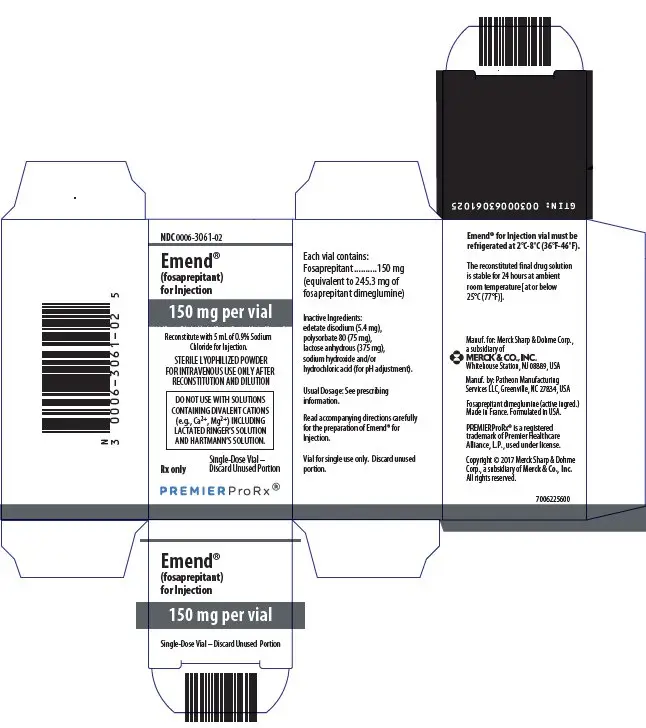 |
|  |
| 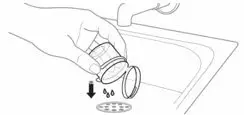 |
| 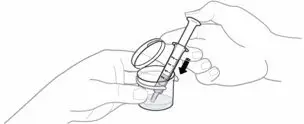 |
|  |
| 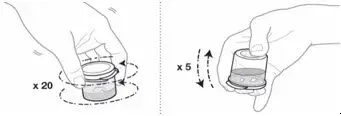 |
| 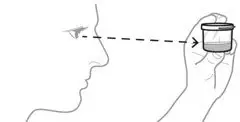 |
|  |
| Make sure no air is in the dispenser - if air is present, remove. Make sure the dispenser contains the prescribed dose. | |
| 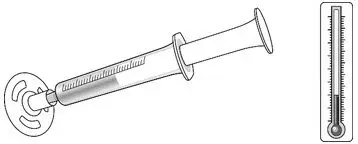 |
|
4. Contraindications
EMEND is contraindicated in patients:
- who are hypersensitive to any component of the product. Hypersensitivity reactions including anaphylactic reactions have been reported [see Adverse Reactions (6.2)].
- taking pimozide. Inhibition of CYP3A4 by aprepitant could result in elevated plasma concentrations of this drug which is a CYP3A4 substrate, potentially causing serious or life-threatening reactions, such as QT prolongation, a known adverse reaction of pimozide [see Warnings and Precautions (5.1)].
5. Warnings and Precautions
5.1 Clinically Significant CYP3A4 Drug Interactions
Aprepitant is a substrate, a weak-to-moderate (dose-dependent) inhibitor, and an inducer of CYP3A4.
- Use of EMEND with other drugs that are CYP3A4 substrates, may result in increased plasma concentration of the concomitant drug.
- Use of pimozide with EMEND is contraindicated due to the risk of significantly increased plasma concentrations of pimozide, potentially resulting in prolongation of the QT interval, a known adverse reaction of pimozide [see Contraindications (4)].
- Use of EMEND with strong or moderate CYP3A4 inhibitors (e.g., ketoconazole, diltiazem) may increase plasma concentrations of aprepitant and result in an increased risk of adverse reactions related to EMEND.
- Use of EMEND with strong CYP3A4 inducers (e.g., rifampin) may result in a reduction in aprepitant plasma concentrations and decreased efficacy of EMEND.
See Table 8 and Table 9 for a listing of potentially significant drug interactions [see Drug Interactions (7.1, 7.2)].
5.2 Decrease in INR with Concomitant Warfarin
Coadministration of EMEND with warfarin, a CYP2C9 substrate, may result in a clinically significant decrease in International Normalized Ratio (INR) of prothrombin time [see Clinical Pharmacology (12.3)]. Monitor the INR in patients on chronic warfarin therapy in the 2-week period, particularly at 7 to 10 days, following initiation of the 3-day regimen of EMEND with each chemotherapy cycle [see Drug Interactions (7.1)].
5.3 Risk of Reduced Efficacy of Hormonal Contraceptives
Upon coadministration with EMEND, the efficacy of hormonal contraceptives may be reduced during administration of and for 28 days following the last dose of EMEND [see Clinical Pharmacology (12.3)]. Advise patients to use effective alternative or back-up methods of contraception during treatment with EMEND and for 1 month following the last dose of EMEND [see Drug Interactions (7.1), Use in Specific Populations (8.3)].
6. Adverse Reactions/Side Effects
6.1 Clinical Trials Experience
Because clinical trials are conducted under widely varying conditions, adverse reaction rates observed in the clinical trials of a drug cannot be directly compared to rates in the clinical trials of another drug and may not reflect the rates observed in clinical practice.
The overall safety of EMEND was evaluated in approximately 6800 individuals.
6.2 Postmarketing Experience
The following adverse reactions have been identified during post-approval use of EMEND. Because these reactions are reported voluntarily from a population of uncertain size, it is not always possible to reliably estimate their frequency or establish a causal relationship to drug exposure.
Skin and subcutaneous tissue disorders: pruritus, rash, urticaria, Stevens-Johnson syndrome/toxic epidermal necrolysis.
Immune system disorders: hypersensitivity reactions including anaphylactic reactions [see Contraindications (4)].
Nervous system disorders: ifosfamide-induced neurotoxicity reported after EMEND and ifosfamide coadministration.
7. Drug Interactions
7.1 Effect of Aprepitant on the Pharmacokinetics of Other Drugs
Aprepitant is a substrate, a weak-to-moderate (dose-dependent) inhibitor, and an inducer of CYP3A4. Aprepitant is also an inducer of CYP2C9 [see Clinical Pharmacology (12.3)].
Aprepitant acts as a moderate inhibitor of CYP3A4 when administered as a 3-day regimen (125-mg/80-mg/80-mg) and can increase plasma concentrations of concomitant drugs that are substrates for CYP3A4. Some substrates of CYP3A4 are contraindicated with EMEND [see Contraindications (4)]. Dosage adjustment of some CYP3A4 and CYP2C9 substrates may be warranted, as shown in Table 8.
| CYP3A4 Substrates | |
| Pimozide | |
| Clinical Impact | Increased pimozide exposure. |
| Intervention | EMEND is contraindicated [see Contraindications (4)]. |
| Benzodiazepines | |
| Clinical Impact | Increased exposure to midazolam or other benzodiazepines metabolized via CYP3A4 (alprazolam, triazolam) may increase the risk of adverse reactions [see Clinical Pharmacology (12.3)]. |
| Intervention |
|
| Dexamethasone | |
| Clinical Impact | Increased dexamethasone exposure [see Clinical Pharmacology (12.3)]. |
| Intervention | Reduce the dose of oral dexamethasone by approximately 50% [see Dosage and Administration (2.1)]. |
| Methylprednisolone | |
| Clinical Impact | Increased methylprednisolone exposure [see Clinical Pharmacology (12.3)]. |
| Intervention |
|
| Chemotherapeutic agents that are metabolized by CYP3A4 | |
| Clinical Impact | Increased exposure of the chemotherapeutic agent may increase the risk of adverse reactions [see Clinical Pharmacology (12.3)]. |
| Intervention | Vinblastine, vincristine, or ifosfamide or other chemotherapeutic agents
|
| Hormonal Contraceptives | |
| Clinical Impact | Decreased hormonal exposure during administration of and for 28 days after administration of the last dose of EMEND [see Warnings and Precautions (5.3), Use in Specific Populations (8.3), Clinical Pharmacology (12.3)]. |
| Intervention | Effective alternative or back-up methods of contraception (such as condoms and spermicides) should be used during treatment with EMEND and for 1 month following the last dose of EMEND. |
| Examples | birth control pills, skin patches, implants, and certain IUDs |
| CYP2C9 Substrates | |
| Warfarin | |
| Clinical Impact | Decreased warfarin exposure and decreased prothrombin time (INR) [see Warnings and Precautions (5.2), Clinical Pharmacology (12.3)]. |
| Intervention | In patients on chronic warfarin therapy, monitor the prothrombin time (INR) in the 2-week period, particularly at 7 to 10 days, following initiation of the 3-day EMEND regimen with each chemotherapy cycle. |
| Other | |
| 5-HT3 Antagonists | |
| Clinical Impact | No change in the exposure of the 5-HT3 antagonist [see Clinical Pharmacology (12.3)]. |
| Intervention | No dosage adjustment needed |
| Examples | ondansetron, granisetron, dolasetron |
7.2 Effect of Other Drugs on the Pharmacokinetics of Aprepitant
Aprepitant is a CYP3A4 substrate [see Clinical Pharmacology (12.3)]. Co-administration of EMEND with drugs that are inhibitors or inducers of CYP3A4 may result in increased or decreased plasma concentrations of aprepitant, respectively, as shown in Table 9.
| Moderate to Strong CYP3A4 Inhibitors | |
| Clinical Impact | Significantly increased exposure of aprepitant may increase the risk of adverse reactions associated with EMEND [see Adverse Reactions (6.1) and Clinical Pharmacology (12.3)]. |
| Intervention | Avoid concomitant use of EMEND. |
| Examples | Moderate inhibitor:
diltiazem Strong inhibitors: ketoconazole, itraconazole, nefazodone, troleandomycin, clarithromycin, ritonavir, nelfinavir |
| Strong CYP3A4 Inducers | |
| Clinical Impact | Substantially decreased exposure of aprepitant in patients chronically taking a strong CYP3A4 inducer may decrease the efficacy of EMEND [see Clinical Pharmacology (12.3)]. |
| Intervention | Avoid concomitant use of EMEND. |
| Examples | rifampin, carbamazepine, phenytoin |
8. Use In Specific Populations
8.4 Pediatric Use
The safety and effectiveness of EMEND for oral suspension have been established in pediatric patients 6 months of age and older and EMEND capsules in pediatric patients 12 years of age and older for the prevention of acute and delayed nausea and vomiting associated with initial and repeat courses of HEC, including high-dose cisplatin, and MEC. Use of EMEND in these age groups is supported by evidence from 302 pediatric patients in a randomized, double-blind, active comparator controlled clinical study (n = 207 patients aged 6 months to less than 12 years, n = 95 patients aged 12 through 17 years). EMEND was studied in combination with ondansetron with or without dexamethasone (at the discretion of the physician) [see Clinical Studies (14.3)]. Adverse reactions were similar to those reported in adult patients [see Adverse Reactions (6.1)].
The safety and effectiveness of EMEND for the prevention of nausea and vomiting associated with HEC or MEC have not been established in patients less than 6 months.
8.5 Geriatric Use
Of the 544 adult cancer patients treated with EMEND in CINV clinical studies, 31% were aged 65 and over, while 5% were aged 75 and over. Other reported clinical experience with EMEND has not identified differences in responses between elderly and younger patients. In general, use caution when dosing elderly patients as they have a greater frequency of decreased hepatic, renal or cardiac function and concomitant disease or other drug therapy [see Clinical Pharmacology (12.3)].
8.6 Patients with Renal Impairment
The pharmacokinetics of aprepitant in patients with severe renal impairment and those with end stage renal disease (ESRD) requiring hemodialysis were similar to those of healthy subjects with normal renal function. No dosage adjustment is necessary for patients with any degree of renal impairment or for patients with ESRD undergoing hemodialysis.
8.7 Patients with Hepatic Impairment
The pharmacokinetics of aprepitant in patients with mild and moderate hepatic impairment were similar to those of healthy subjects with normal hepatic function. No dosage adjustment is necessary for patients with mild to moderate hepatic impairment (Child-Pugh score 5 to 9). There are no clinical or pharmacokinetic data in patients with severe hepatic impairment (Child-Pugh score greater than 9). Therefore, additional monitoring for adverse reactions in these patients may be warranted when EMEND is administered [see Clinical Pharmacology (12.3)].
10. Overdosage
No specific information is available on the treatment of overdosage.
Drowsiness and headache were reported in one patient who ingested 1440 mg of EMEND (approximately 11 times the maximum recommended single dose).
In the event of overdose, EMEND should be discontinued and general supportive treatment and monitoring should be provided. Because of the antiemetic activity of EMEND, drug-induced emesis may not be effective in cases of EMEND overdosage.
Aprepitant is not removed by hemodialysis.
11. Emend Description
EMEND capsules contain the active ingredient, aprepitant. Aprepitant is a substance P/neurokinin 1 (NK1) receptor antagonist, an antiemetic agent, chemically described as 5-[[(2R,3S)-2-[(1R)-1-[3,5-bis(trifluoromethyl)phenyl]ethoxy]-3-(4-fluorophenyl)-4-morpholinyl]methyl]-1,2-dihydro-3H-1,2,4-triazol-3-one.
Its empirical formula is C23H21F7N4O3, and its structural formula is:
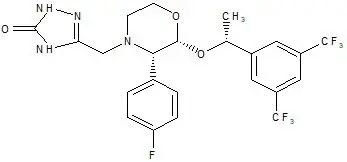
Aprepitant is a white to off-white crystalline solid, with a molecular weight of 534.43. It is practically insoluble in water. Aprepitant is sparingly soluble in ethanol and isopropyl acetate and slightly soluble in acetonitrile.
Each capsule of EMEND for oral administration contains either 80 mg or 125 mg of aprepitant and the following inactive ingredients: sucrose, microcrystalline cellulose, hydroxypropyl cellulose and sodium lauryl sulfate. The capsule shell excipients are gelatin, titanium dioxide, and may contain sodium lauryl sulfate and silicon dioxide. The 125-mg capsule also contains red ferric oxide and yellow ferric oxide.
Each pouch of EMEND for oral suspension 125 mg contains 125 mg of aprepitant and the following inactive ingredients: sucrose, lactose, hydroxypropyl cellulose, sodium lauryl sulfate, red iron oxide, and sodium stearyl fumarate.
12. Emend - Clinical Pharmacology
12.1 Mechanism of Action
Aprepitant is a selective high-affinity antagonist of human substance P/neurokinin 1 (NK1) receptors. Aprepitant has little or no affinity for serotonin (5-HT3), dopamine, and corticosteroid receptors, the targets of existing therapies for chemotherapy-induced nausea and vomiting (CINV).
Aprepitant has been shown in animal models to inhibit emesis induced by cytotoxic chemotherapeutic agents, such as cisplatin, via central actions. Animal and human Positron Emission Tomography (PET) studies with aprepitant have shown that it crosses the blood brain barrier and occupies brain NK1 receptors. Animal and human studies show that aprepitant augments the antiemetic activity of the 5-HT3-receptor antagonist ondansetron and the corticosteroid dexamethasone and inhibits both the acute and delayed phases of cisplatin-induced emesis.
12.3 Pharmacokinetics
Drug Interactions Studies
Aprepitant is a substrate, a moderate (dose-dependent) inhibitor, and an inducer of CYP3A4. Aprepitant is also an inducer of CYP2C9. Aprepitant is unlikely to interact with drugs that are substrates for the P-glycoprotein transporter.
Effects of Aprepitant on the Pharmacokinetics of Other Drugs
14. Clinical Studies
14.1 Prevention of Nausea and Vomiting Associated with HEC in Adults
Oral administration of EMEND in combination with ondansetron and dexamethasone (EMEND regimen) has been shown to prevent acute and delayed nausea and vomiting associated with HEC including high-dose cisplatin, and nausea and vomiting associated with MEC.
In Studies 1 and 2, both multicenter, randomized, parallel, double-blind, controlled clinical studies in adults, EMEND in combination with ondansetron and dexamethasone was compared with standard therapy (ondansetron and dexamethasone alone) in patients receiving a chemotherapy regimen that included cisplatin greater than 50 mg/m2 (mean cisplatin dose = 80.2 mg/m2). See Table 11.
In these studies, 95% of the patients in the EMEND group received a concomitant chemotherapeutic agent in addition to protocol-mandated cisplatin. The most common chemotherapeutic agents and the number of EMEND patients exposed follows: etoposide (106), fluorouracil (100), gemcitabine (89), vinorelbine (82), paclitaxel (52), cyclophosphamide (50), doxorubicin (38), docetaxel (11).
Of the 550 patients who were randomized to receive the EMEND regimen, 42% were women, 58% men, 59% White, 3% Asian, 5% Black, 12% Hispanic American, and 21% Multi-Racial. The EMEND-treated patients in these clinical studies ranged from 14 to 84 years of age, with a mean age of 56 years. A total of 170 patients were 65 years or older, with 29 patients being 75 years or older.
| Day 1 | Day 2 | Day 3 | Day 4 | |
|---|---|---|---|---|
|
||||
| CINV EMEND Regimen | ||||
| Oral EMEND† | 125 mg | 80 mg | 80 mg | none |
| Oral Dexamethasone‡ | 12 mg | 8 mg | 8 mg | 8 mg |
| Ondansetron | 5-HT3 antagonist§ | none | none | none |
| CINV Standard Therapy | ||||
| Oral Dexamethasone | 20 mg | 8 mg twice daily | 8 mg twice daily | 8 mg twice daily |
| Ondansetron | 5-HT3 antagonist§ | none | none | none |
The antiemetic activity of EMEND was evaluated during the acute phase (0 to 24 hours post-cisplatin treatment), the delayed phase (25 to 120 hours post-cisplatin treatment) and overall (0 to 120 hours post-cisplatin treatment) in Cycle 1. Efficacy was based on evaluation of the following endpoints in which emetic episodes included vomiting, retching, or dry heaves:
Primary endpoint:
- complete response (defined as no emetic episodes and no use of rescue therapy as recorded in patient diaries)
Other prespecified endpoints:
- complete protection (defined as no emetic episodes, no use of rescue therapy, and a maximum nausea visual analogue scale [VAS] score less than 25 mm on a 0 to 100 mm scale)
- no emesis (defined as no emetic episodes regardless of use of rescue therapy)
- no nausea (maximum VAS less than 5 mm on a 0 to 100 mm scale)
- no significant nausea (maximum VAS less than 25 mm on a 0 to 100 mm scale)
A summary of the key study results from each individual study analysis is shown in Table 12. In both studies, a statistically significantly higher proportion of patients receiving the EMEND regimen in Cycle 1 had a complete response in the overall phase (primary endpoint), compared with patients receiving standard therapy. A statistically significant difference in complete response in favor of the EMEND regimen was also observed when the acute phase and the delayed phase were analyzed separately.
| Study 1 | Study 2 | |||||
|---|---|---|---|---|---|---|
| ENDPOINTS | EMEND Regimen (N=260)* % | Standard Therapy (N=261)* % | p-Value | EMEND Regimen (N=261)* % | Standard Therapy (N=263)* % | p-Value |
| Visual analogue scale (VAS) score range: 0 mm=no nausea; 100 mm=nausea as bad as it could be. | ||||||
|
||||||
| PRIMARY ENDPOINT | ||||||
| Complete Response | ||||||
| Overall† | 73 | 52 | <0.001 | 63 | 43 | <0.001 |
| OTHER PRESPECIFIED ENDPOINTS | ||||||
| Complete Response | ||||||
| Acute phase‡ | 89 | 78 | <0.001 | 83 | 68 | <0.001 |
| Delayed phase§ | 75 | 56 | <0.001 | 68 | 47 | <0.001 |
| Complete Protection | ||||||
| Overall | 63 | 49 | 0.001 | 56 | 41 | <0.001 |
| Acute phase | 85 | 75 | NS¶ | 80 | 65 | <0.001 |
| Delayed phase | 66 | 52 | <0.001 | 61 | 44 | <0.001 |
| No Emesis | ||||||
| Overall | 78 | 55 | <0.001 | 66 | 44 | <0.001 |
| Acute phase | 90 | 79 | 0.001 | 84 | 69 | <0.001 |
| Delayed phase | 81 | 59 | <0.001 | 72 | 48 | <0.001 |
| No Nausea | ||||||
| Overall | 48 | 44 | NS# | 49 | 39 | NS¶ |
| Delayed phase | 51 | 48 | NS# | 53 | 40 | NS¶ |
| No Significant Nausea | ||||||
| Overall | 73 | 66 | NS# | 71 | 64 | NS# |
| Delayed phase | 75 | 69 | NS# | 73 | 65 | NS# |
In both studies, the estimated time to first emesis after initiation of cisplatin treatment was longer with the EMEND regimen, and the incidence of first emesis was reduced in the EMEND regimen group compared with standard therapy group as depicted in the Kaplan-Meier curves in Figure 1.
| Figure 1: Percent of Patients Receiving HEC Who Remain Emesis Free Over Time — Cycle 1 |
|---|
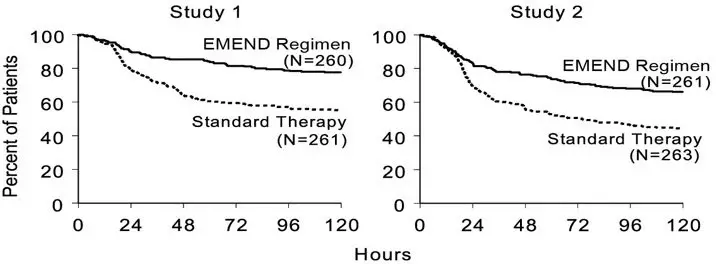 |
| p-Value <0.001 based on a log rank test for Study 1 and Study 2; nominal p-values not adjusted for multiplicity. |
14.2 Prevention of Nausea and Vomiting Associated with MEC in Adults
EMEND was studied in two randomized, double-blind, parallel-group studies (Studies 3 and 4) in adult patients receiving MEC.
In Study 3, in breast cancer patients, EMEND in combination with ondansetron and dexamethasone was compared with standard therapy (ondansetron and dexamethasone) in patients receiving a MEC regimen that included cyclophosphamide 750-1500 mg/m2; or cyclophosphamide 500-1500 mg/m2 and doxorubicin (less than or equal to 60 mg/m2) or epirubicin (less than or equal to 100 mg/m2). See Table 13.
In this study, the most common combinations were cyclophosphamide + doxorubicin (61%); and cyclophosphamide + epirubicin + fluorouracil (22%).
Of the 438 patients who were randomized to receive the EMEND regimen, 99.5% were women. Of these, approximately 80% were White, 8% Black, 8% Asian, 4% Hispanic, and less than 1% Other. The EMEND-treated patients in this clinical study ranged from 25 to 78 years of age, with a mean age of 53 years; 70 patients were 65 years or older, with 12 patients being over 74 years.
| Day 1 | Day 2 | Day 3 | |
|---|---|---|---|
|
|||
| CINV EMEND Regimen | |||
| Oral EMEND† | 125 mg | 80 mg | 80 mg |
| Oral Dexamethasone | 12 mg‡ | none | none |
| Oral Ondansetron | 8 mg × 2 doses§ | none | none |
| CINV Standard Therapy | |||
| Oral Dexamethasone | 20 mg‡ | none | none |
| Oral Ondansetron | 8 mg × 2 doses§ | 8 mg twice daily | 8 mg twice daily |
The antiemetic activity of EMEND was evaluated based on the following endpoints in which emetic episodes included vomiting, retching, or dry heaves:
Primary endpoint:
- complete response (defined as no emetic episodes and no use of rescue therapy as recorded in patient diaries) in the overall phase (0 to 120 hours post-chemotherapy)
Other prespecified endpoints:
- no emesis (defined as no emetic episodes regardless of use of rescue therapy)
- no nausea (maximum VAS less than 5 mm on a 0 to 100 mm scale)
- no significant nausea (maximum VAS less than 25 mm on a 0 to 100 mm scale)
- complete protection (defined as no emetic episodes, no use of rescue therapy, and a maximum nausea visual analogue scale [VAS] score less than 25 mm on a 0 to 100 mm scale)
- complete response during the acute and delayed phases.
A summary of the key results from Study 3 is shown in Table 14. In Study 3, a statistically significantly (p=0.015) higher proportion of patients receiving the EMEND regimen (51%) in Cycle 1 had a complete response (primary endpoint) during the overall phase compared with patients receiving standard therapy (42%). The difference between treatment groups was primarily driven by the "No Emesis Endpoint", a principal component of this composite primary endpoint. In addition, a higher proportion of patients receiving the EMEND regimen in Cycle 1 had a complete response during the acute (0-24 hours) and delayed (25-120 hours) phases compared with patients receiving standard therapy; however, the treatment group differences failed to reach statistical significance, after multiplicity adjustments.
| ENDPOINTS | EMEND Regimen (N=433)* % | Standard Therapy (N=424)* % | p-Value |
|---|---|---|---|
|
|||
| PRIMARY ENDPOINT† | |||
| Complete Response | 51 | 42 | 0.015 |
| OTHER PRESPECIFIED ENDPOINTS† | |||
| No Emesis | 76 | 59 | NS‡ |
| No Nausea | 33 | 33 | NS |
| No Significant Nausea | 61 | 56 | NS |
| No Rescue Therapy | 59 | 56 | NS |
| Complete Protection | 43 | 37 | NS |
14.3 Prevention of Nausea and Vomiting Associated with HEC or MEC in Pediatric Patients
In a randomized, double-blind, active comparator-controlled clinical study that included 302 pediatric patients aged 6 months to 17 years receiving HEC or MEC, EMEND in combination with ondansetron was compared to ondansetron alone (control regimen) for the prevention of CINV (Study 5). Intravenous dexamethasone was permitted as part of the antiemetic regimen in both treatment groups, at the discretion of the physician. A 50% dose reduction of dexamethasone was required for patients in the EMEND group, reflecting a dosage adjustment to account for a drug interaction [see Clinical Pharmacology (12.3)]. No dexamethasone dose reduction was required for patients who received the control regimen.
Eligible patients had documented malignancy at either an original diagnosis or relapse and were scheduled to receive emetogenic chemotherapy or a chemotherapy regimen not previously tolerated due to vomiting along with ondansetron as part of their antiemetic regimen.
Of the 152 pediatric patients randomized to receive the EMEND regimen, 55% were male, 45% female, 78% White, 7% Asian, 0% Black, 24% Hispanic, and 13% Multi-Racial. The most common primary malignancies in subjects receiving the EMEND regimen were osteosarcoma (11%), Ewing's sarcoma (11%), neuroblastoma (9%) and rhabdomyosarcoma (8%). Other concomitant chemotherapy agents commonly administered and the number of EMEND patients exposed were: vincristine sulfate (65), etoposide (59), doxorubicin (48), ifosfamide (45), carboplatin (39), and cisplatin (35).
The treatment regimens in Study 5 for pediatric patients are defined in Table 16. Of the pediatric patients, 29% in the EMEND regimen and 28% in the control regimen used dexamethasone as part of the antiemetic regimen in Cycle 1.
| Day 1 | Day 2 | Day 3 | |
|---|---|---|---|
|
|||
| CINV EMEND Regimen | |||
| Pediatric Patients 6 Months to less than 12 Years of Age† | 3 mg/kg body weight oral suspension | 2 mg/kg body weight oral suspension | 2 mg/kg body weight oral suspension |
| Pediatric Patients 12 to 17 Years of Age† | 125 mg capsule | 80 mg capsule | 80 mg capsule |
| Ondansetron | Per standard of care‡ | none | none |
| CINV Control Regimen§ | |||
| Ondansetron | Per standard of care‡ | none | none |
The antiemetic activity of EMEND was evaluated over a 5-day (120 hour) period following the initiation of chemotherapy on Day 1. The primary endpoint in Study 5 was complete response in the delayed phase (25 to 120 hours following chemotherapy) in Cycle 1. Patients had the opportunity to receive open-label EMEND in subsequent cycles (Optional Cycles 2-6); however, efficacy was not assessed in these optional cycles. Overall efficacy was based on the evaluation of the following endpoints:
Primary endpoint:
- complete response (no vomiting, retching and no use of rescue medication) in the delayed phase (25 to 120 hours following initiation of chemotherapy)
Other prespecified endpoints:
- complete response in the acute phase (0 to 24 hours following initiation of chemotherapy)
- complete response in the overall phase (up to 120 hours following initiation of chemotherapy)
- no vomiting (defined as no emesis, retching or dry heaves, regardless of use of rescue medication) in the overall phase
- safety and tolerability
A summary of the key study results is shown in Table 17.
| EMEND Regimen n/m (%) | Control Regimen n/m (%) |
|
|---|---|---|
| n/m = Number of patients with desired response/number of patients included in time point. | ||
| Acute Phase: 0 to 24 hours following initiation of chemotherapy. | ||
| Delayed Phase: 25 to 120 hours following initiation of chemotherapy. | ||
| Overall Phase: 0 to 120 hours following initiation of chemotherapy. | ||
|
||
| PRIMARY ENDPOINT | ||
| Complete Response* - Delayed phase | 77/152 (50.7)† | 39/150 (26.0) |
| OTHER PRESPECIFIED ENDPOINTS | ||
| Complete Response* – Acute phase | 101/152 (66.4)‡ | 78/150 (52.0) |
| Complete Response* – Overall phase | 61/152 (40.1)† | 30/150 (20.0) |
16. How is Emend supplied
80-mg capsules: White, opaque, hard gelatin capsule with "461" and "80 mg" printed radially in black ink on the body. They are supplied as follows:
NDC 0006-0461-02 unit-of-use BiPack of 2
Unit-of-use TriPack containing one 125-mg capsule and two 80-mg capsules. 125 mg-capsules: Opaque, hard gelatin capsule with white body and pink cap with “462” and “125 mg” printed radially in black ink on the body. 80-mg capsules: White, opaque, hard gelatin capsule with “461” and “80 mg” printed radially in black ink on the body.
NDC 0006-3862-03.
125 mg for oral suspension: Pink to light pink powder, in a single-use pouch, packaged as a kit with one 1 mL oral dosing dispenser, one 5 mL oral dosing dispenser, one cap and one mixing cup. It is supplied as follows:
NDC 0006-3066-03 – unit of use carton.
17. Patient Counseling Information
Advise the patient to read the FDA-approved patient labeling (Patient Information).
| Instructions for Use
EMEND® (EE-mend)
Take by mouth only |
||
| How to give a dose of EMEND for oral suspension | ||
| The healthcare provider has prepared the dose of EMEND for you or your child. | ||
|
|
|
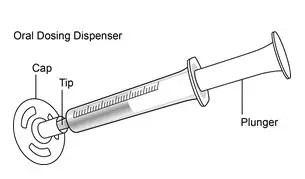 | 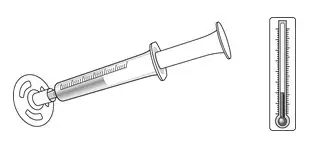 |
|
|
||
|
|
|
 | 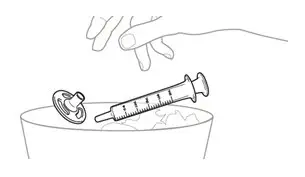 |
|
The color of the medicine in the oral dosing dispenser may be different shades of pink (light pink to dark pink). This is normal and the medicine is okay to use.
Call the healthcare provider if you or your child is not able to take the prescribed dose. | ||
| For more information go to www.emend.com or call 1-800-622-4477. This Instructions for Use has been approved by the U.S. Food and Drug Administration. Distributed by: Merck Sharp & Dohme LLC, Rahway, NJ 07065, USA For patent information: www.msd.com/research/patent Copyright © 2015-2022 Merck & Co., Inc., Rahway, NJ, USA, and its affiliates. All rights reserved. Issued: 05/2022 usifu-mk0869-mf-2205r001 |
||
PRINCIPAL DISPLAY PANEL - 80 mg Capsule Dose Pack
NDC 0006-0461-02
BiPack
2 capsules
EMEND®
(aprepitant) capsules
80 mg
For Adults and
Pediatric Patients
12 years of Age and Older
You have already been given
a capsule of EMEND (aprepitant) to
prevent nausea and vomiting before
your chemotherapy on Day 1.
The two capsules in this package
are to be taken on Days 2 and 3.
Each capsule contains 80 mg
of aprepitant.
USUAL DOSAGE:
See accompanying circular.
Rx only
Keep this and all drugs out of
the reach of children.
Dist. by: Merck Sharp & Dohme LLC
Rahway, NJ 07065, USA
Manuf. by: Alkermes Pharma Ireland Limited, Athlone, Ireland
Aprepitant (active ingred.) Made in Switzerland.
Formulated in Ireland.
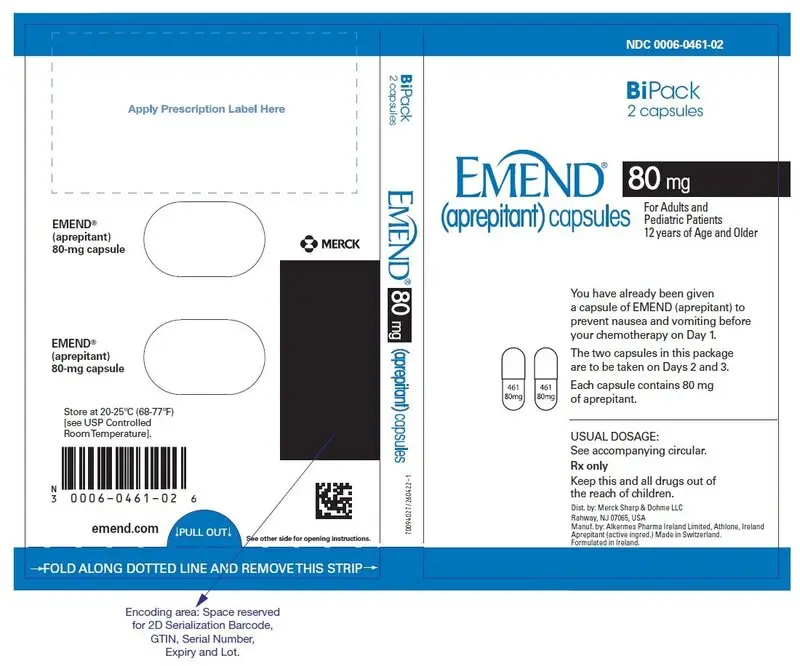
PRINCIPAL DISPLAY PANEL - 125 mg Capsule Carton
NDC 0006-0462-06
125 mg
EMEND®
(APREPITANT) CAPSULES
For Adults and
Pediatric Patients
12 years of Age and Older
Each capsule contains 125 mg aprepitant.
Store at 20-25°C (68-77°F) [see USP Controlled Room Temperature].
USUAL DOSAGE: See accompanying circular.
Rx only
This is a bulk package and not intended for dispensing.
Package not child resistant.
6 capsules

PRINCIPAL DISPLAY PANEL - 3 Capsule Kit Carton
NDC 0006-3862-03
TriPack
3 capsules
EMEND®
(aprepitant) capsules
125 mg 80 mg
For Adults and
Pediatric Patients
12 years of Age and Older
One 125-mg capsule contains
125 mg aprepitant.
Two 80-mg capsules each containing
80 mg of aprepitant.
USUAL DOSAGE:
See accompanying circular.
Rx only
Keep this and all drugs out of
the reach of children.
Dist. by: Merck Sharp & Dohme LLC
Rahway, NJ 07065, USA
Manuf. by: Alkermes Pharma Ireland Limited, Athlone, Ireland
Aprepitant (active ingred.) Made in Switzerland.
Formulated in Ireland.
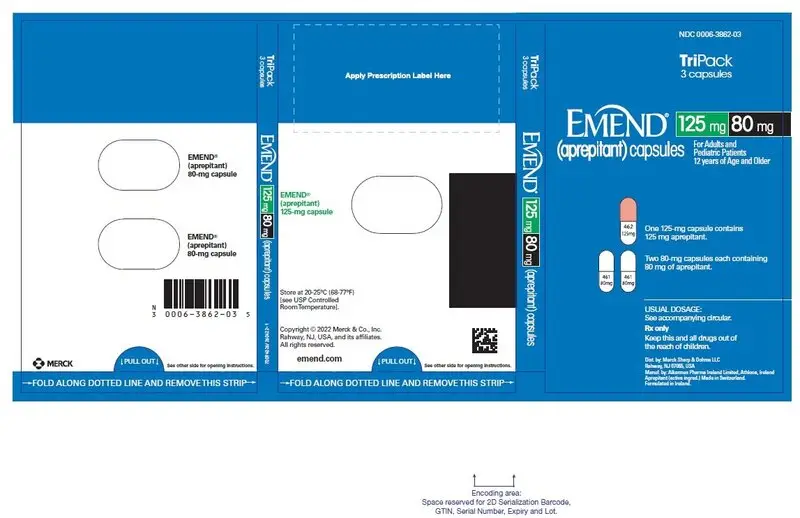
PRINCIPAL DISPLAY PANEL - 40 mg Capsule Carton
NDC 0006-0464-10
40 mg
EMEND®
(APREPITANT) CAPSULE
Each capsule contains 40 mg aprepitant.
Rx only
Package not child resistant. Keep this
and all drugs out of the reach of children.
Dist. by: Merck Sharp & Dohme Corp., a subsidiary of
MERCK & CO., INC., Whitehouse Station, NJ 08889, USA
Manuf. by: Alkermes Pharma Ireland Limited, Athlone, Ireland
Formulated in Ireland
1 Capsule
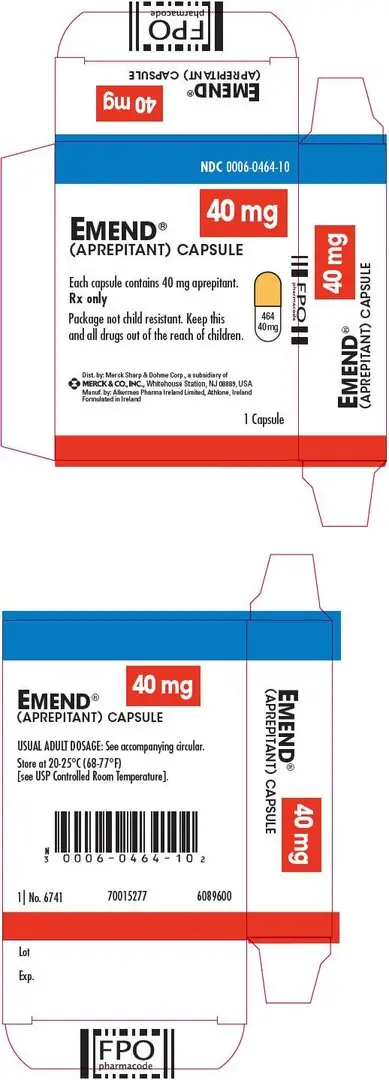
| EMEND
aprepitant capsule |
||||||||||||||||||||||||||||||
|
||||||||||||||||||||||||||||||
|
||||||||||||||||||||||||||||||
|
||||||||||||||||||||||||||||||
|
||||||||||||||||||||||||||||||
|
||||||||||||||||||||||||||||||
|
||||||||||||||||||||||||||||||
| EMEND
aprepitant capsule |
||||||||||||||||||||||
|
||||||||||||||||||||||
|
||||||||||||||||||||||
|
||||||||||||||||||||||
|
||||||||||||||||||||||
|
||||||||||||||||||||||
|
||||||||||||||||||||||
| EMEND
aprepitant kit |
||||||||||||||||||||||
|
||||||||||||||||||||||
|
||||||||||||||||||||||
|
||||||||||||||||||||||
|
||||||||||||||||||||||
|
||||||||||||||||||||||
|
||||||||||||||||||||||
|
||||||||||||||||||||||
|
||||||||||||||||||||||
|
||||||||||||||||||||||
|
||||||||||||||||||||||
|
||||||||||||||||||||||
|
||||||||||||||||||||||
|
||||||||||||||||||||||
|
||||||||||||||||||||||
|
||||||||||||||||||||||
|
||||||||||||||||||||||
|
||||||||||||||||||||||
|
||||||||||||||||||||||
| EMEND
aprepitant capsule |
||||||||||||||||||||||||||||||
|
||||||||||||||||||||||||||||||
|
||||||||||||||||||||||||||||||
|
||||||||||||||||||||||||||||||
|
||||||||||||||||||||||||||||||
|
||||||||||||||||||||||||||||||
|
||||||||||||||||||||||||||||||
| EMEND
aprepitant powder, for suspension |
||||||||||||||||||||
|
||||||||||||||||||||
|
||||||||||||||||||||
|
||||||||||||||||||||
|
||||||||||||||||||||
|
||||||||||||||||||||
|
||||||||||||||||||||
| Labeler - Merck Sharp & Dohme LLC (118446553) |




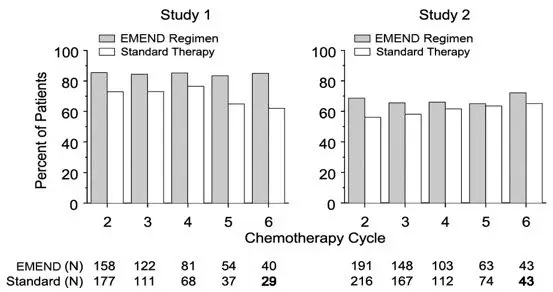
 Read the Patient Information and Instructions for
Read the Patient Information and Instructions for
